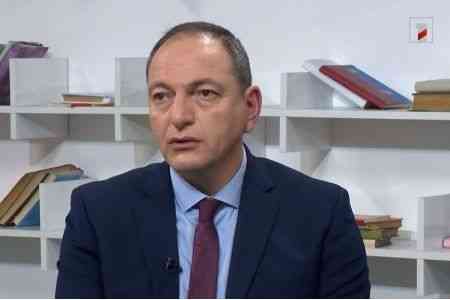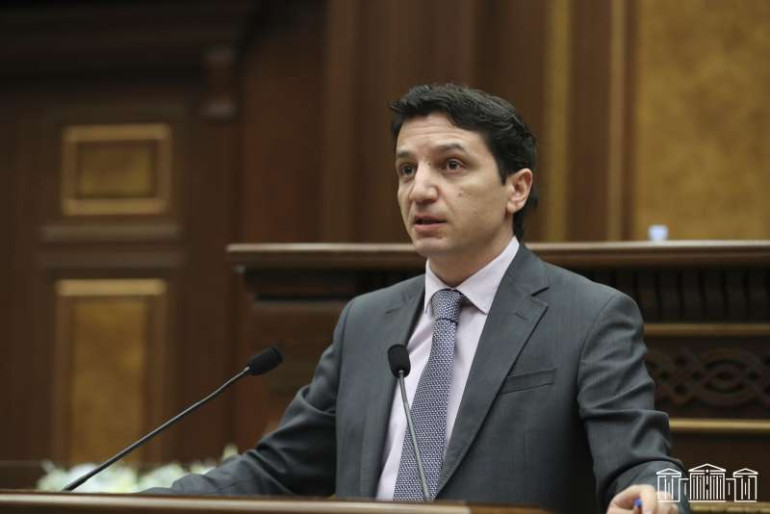-Mr. Kharazyan, on February 2, 2023, the Armenian Cabinet approved the Universal Health Insurance (UHI) Concept presented by the Ministry of Health, which outlined a four-year rollout plan. The year 2023 was designated as a “preparatory” period, with 2024-2026 serving as a “test phase” and full implementation slated for 2027. As per the schedule, the system’s implementation phase is expected to commence this July, with approximately 18 billion drams allocated in the 2024 state budget. Are we ready to proceed with the launch of the UHI system in July?
– Within the framework of the approved Concept, it was supposed to introduce the IUS from July 2024, but, unfortunately, the RA Law “On Comprehensive Health Insurance” has not yet been adopted, despite the fact that the draft document itself was ready in April 2023, put into circulation, and a number of proposals were received on it. The delay in the adoption of the legal act is mainly due to the determination of the “ability” of the state treasury to fully subsidize the insurance premiums of the first group of beneficiaries already in 2024.
And without this document we will not be able to adopt the relevant by-laws, form the Comprehensive Health Insurance Fund, which will provide state-subsidized insurance for population groups in full. In this regard, at this stage the government is currently discussing the revision of both the timing and the strategy for implementing the system.
– Have you already calculated the amount of insurance premiums?
– The cost of compulsory medical insurance in Armenia will be about 164,400 drams per year. Monthly payments to the insured person will be 13,700 drams.
At the same time, a system of subsidies for people with low incomes will be in effect: the state is ready to subsidize insurance premiums in the amount of up to 60% of the cost of the policy for people with a monthly income of no more than twice the minimum wage. The subsidy for people with a monthly income in the range of 150-300 thousand drams (gross salary) will be 40%. And people with a higher income will have to pay the premiums themselves in full. A subsidy of 20% is also provided for each person affiliated with the insured person (family members), in the event of joining the system.
– What does the insured person receive under this policy?
– The medical care package includes medical services within the framework of hospital and outpatient care (outpatient and polyclinic), a package of free medications for chronic diseases, which will be issued to the patient at the pharmacy. The package also includes expensive cardiac surgery services, treatment of oncological diseases – both chemotherapy (with some price restrictions) and radiation therapy. The package will cover almost all types of operations, if they are not performed using the latest methods. It will also include such diagnostic methods as magnetic resonance imaging (MRI) and computed tomography (CT). Plastic surgery and some rehabilitation procedures will be excluded from the state insurance package.
– The question that was perceived especially painfully by working citizens was whether they would pay for the insurance of non-working citizens ?
– Health insurance in Armenia will cover both citizens of the country and residents of the RA (from the point of view of health insurance, these will be persons who are actually in the country for at least 183 days during the 12 consecutive months preceding the moment of insurance).
However, working citizens will not pay compulsory health insurance contributions for the unemployed. In particular, if a citizen does not work – is not registered with the tax authority and has no income, is not included in any social assistance group, then he is entitled to a minimum package, which will include emergency services, services for diseases that pose a danger to society and those that are necessary in the event of infectious diseases: tuberculosis, infectious services, the same maternity hospital, some outpatient services. He will have to pay for other services out of his own pocket.
– How did you arrive at the figure of 164,400 drams annually? After all, during the first attempt to introduce mandatory health insurance in Armenia – in 2017, it was reported that the cost of the policy would be 6,000 drams per month – on the condition that the citizen pays the insurance in full or 50% is paid by the citizen and the other 50% by the employer. Already during the “attempt number 2” in 2019, the Ministry of Health proposed an option of deductions from salaries of 4-6% from 2022.
– The figure was formed on the basis of actuarial calculations. That is, we took the projected population groups that will be included in the system and assessed the risks associated with their health.
There are two methods of calculation: top-down and bottom-up. The top-down method takes all expenses, in this case within one family, and then divides them among all family members. This method does not take into account the individual needs of each family member. The bottom-up method calculates the specific expenses of each person separately, then adds up the figures to get the annual family budget. We used this method: we took certain groups of the population with similar diseases and took into account the expenses required for their treatment, according to the “regulations”, and not on the basis of what expenses the doctor provided, based on the patient’s solvency and many other factors. If we had “taken up” the statistics of prescribed and performed tests, studies, including the number of MRI and CT scans, the amount would have grown to 250 thousand drams.
Based on the above scheme, we estimated the necessary volume of research for this group, the list of medications required to treat this disease, added the doctor’s salary there and came to the estimated budget. For example, in one group we collected people under 18 years old, who, as expected, have almost identical health expenses, unless, of course, they have a disability and other serious problems, and based on this we calculated the cost of the policy.
– What explains the current transition to fixed insurance payments ? And why did the Ministry of Health abandon the idea of introducing a progressive scale – the more you earn, the more you pay for your health ?
– The country’s financial bloc opposed the introduction of a system of paying contributions as a percentage of salaries, since it could result in a new type of “health” tax. The government’s policy is aimed at reducing direct taxes (in 2019, then Finance Minister Atom Janjughazyan said that the proposed “health tax” is an additional burden for the employee, and in fact it will be placed on the shoulders of the country’s economy – Ed.). This is insurance and it should be in the form of an insurance premium.
In any case, it turns out that the principle remains the same: the more a person earns, the more he pays, since we intend to apply a certain scale, in which people with lower incomes will pay less, and the state will subsidize more.
– How efficient is such a scheme in the absence of clinical protocols, the so-called standards for treating diseases, in connection with which experts have repeatedly expressed their concerns, also questioning the productivity of the future compulsory medical insurance? Will this not lead to the “promotion” of patients for additional paid examinations?
– Clinical protocols have always existed. And they are not a panacea for solving all our problems. Their “presence-absence” is abused among us.
Today, we have protocols for almost all diseases. We have also drawn up a plan for developing treatment protocols, according to which by the end of the year we will have protocols for almost 600 diseases, which will cover 70-80% of all major diseases. They will be approved before the introduction of the IUD.
– What will the process look like?
– For example, you become a beneficiary of compulsory medical insurance from 2027, then you receive a notification from the tax authority that you are insured and are a payer of insurance premiums, then you register in the insurance register, where your electronic certificate is generated (if desired, a plastic policy can also be provided). If an insured event occurs, the patient contacts the outpatient family doctor, who, based on his complaints, refers him to a specialist. The patient will have the opportunity to choose which doctor to go to, but he will have to choose a medical institution only from the list proposed by the Fund. In order to be included in the list, medical centers will have to pass pre-qualification according to the criteria compiled by the Fund.
A limit on insurance compensation for a specific type of service will also be set, and if it is exceeded, the patient will have to pay out of his own pocket.
– What if I already have health insurance from a private company?
– You can continue voluntary insurance with a private company, but the presence of an IUD is mandatory. Private companies can provide citizens with additional medical and other services beyond those established by the mandatory medical insurance package.
– It is assumed that after the introduction of the IUD, the number of visits to medical institutions will increase sharply. Are there any estimates of how much this growth will be and whether medical centers will be able to handle such an influx of patients?
– In the first year of the system’s implementation, that is, starting in 2025, people who were already receiving free medical care under the state order will be insured – we are well informed about them. For us, the following years are more risky. Thus, starting in 2026, people aged 63 and older with serious health problems will join the compulsory medical insurance. In 2027, hired workers from the private sector will be included in the system, information about health risks for whom is extremely limited, and this means more risks and unforeseen expenses for the state treasury.
After the introduction of the IUD system, according to our forecasts, cases of hospital medical care will double – to 27%. I think our health care system is capable of “digesting” this volume and will increase its potential as demand grows.
– The collection of funds for the IUD, the determination of the amount of contributions and expenses, according to the Concept, will be carried out by one body – the Fund, the chairman of the board of which will be the Minister of Health of the Republic of Armenia. Many experts saw corruption risks in this, especially given the conflict of interest. In addition, instead of creating a State Fund, there were recommendations to apply the OSAGO liability insurance model for drivers of vehicles, as an established example of effective public-private cooperation. “It is important to exclude the monopolization of the functions and services of the private sector by the state,” the experts urged.
The Fund will have a Board of Directors or a Board of Trustees (whose “burden” of making key decisions will be placed on their shoulders – Ed.). It will include representatives of the government, including the Ministers of Health, Finance, and public organizations – representatives of medical unions, business, and specialized associations. The procedure for electing NGO representatives will be determined by the government. The composition of the Board of Directors will be appointed by the Prime Minister. The head of the Ministry of Health will be the ex officio Chairman of the Board of Directors of the Fund. This is a generally accepted global practice. However, the Fund will also have the position of Executive Director.
As for the application of the OSAGO model in this case, we have considered this option, taking into account both its positive and negative aspects. But let’s consider the situation within the framework of the “pooling” model. If you have several pools for watering one garden, managing the process is much more complicated than if you organize watering from one source. Thus, we save time, money and resources.
It is also worth noting that the method of implementing health insurance through private organizations is most justified for countries with a large population, for example, like the Netherlands or Switzerland.
– Will the State Fund be authorized to carry out activities to manage the assets entrusted to it, say, following the example of managers of mandatory pension funds? Or could it be that – having made an unsuccessful investment, the beneficiary will be left without funds for compensation?
– After full investment, i.e. compensation payments, the legislator has provided the Fund with the opportunity to submit proposals to the government regarding asset management. We are discussing the possibility of transferring asset management to pension funds – meetings have been held with representatives of mandatory pension funds, there are certain ideas about the prospects of this cooperation.
I consider the prospect of unsuccessful investment to be extremely unlikely. The Fund has been given serious mechanisms of reporting and control over the movement of funds by the Board of Directors and the Government of the Republic of Armenia. The activities of the State Fund will not be legally controlled by the Central Bank, since the standards of insurance activities established by the Financial Regulator are completely different – the principles of forming insurance premiums and the amounts of compensation in our case are enshrined in the Law.
– Mr. Kharazyan, I would like to know what model the compulsory medical insurance system being implemented in the Republic of Armenia will operate on, what country’s experience was taken as a basis… After all, there are the Bismarck and Beveridge models, direct payment and national insurance models, successfully tested in developed countries…
– The division into models was adopted in the 80-90s. After the 2000s, the world has mainly moved along a mixed – the so-called national-social-healthcare model, which will be in tune with the Armenian model of compulsory medical insurance. We studied the experience of Canada, the Baltic countries and many others, and we took advantage of the accumulated and proven experience of many countries.
– In your opinion, when can we finally expect the introduction of compulsory medical insurance?
– I think the practical implementation of the VMS will be postponed until early 2025. Then, according to preliminary estimates, 130 billion drams will be required from the state treasury to subsidize contributions for those under 18, beneficiaries of the social package, people with disabilities (the latter may also include pensioners) and persons included in the social assistance system (about 1.2 million people). From 2026, another 600 thousand beneficiaries are expected to join the insurance system – people aged 63 and older, as well as employees of budgetary organizations, and budgetary allocations will amount to approximately 230-240 billion drams.
From 2027, when the VMS will also include hired workers (plus 500-600 other people), the state will need about 260-270 billion drams to finance subsidies for insurance premiums for about 2.4 million people.





